Life and Legends In the City of Gold
Prelude to Prague
Story & photos by Helena Zukowski
Source: Westworld Magazine
Spring 1999, Volume 25, Number 1
IT WAS A MELLOW, MID-SUMMER evening - my last in Prague - so I lingered at the sidewalk cafe by the Vltava River, soaking up the last sensual images. Birds swooped up debris amid reflections off the dark waters, and gold seemed to be everywhere - 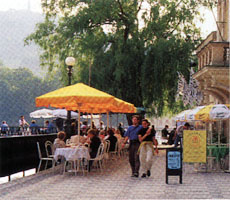 bouncing off the domes of churches, flooding the streets and suffusing the whole city. It's easy to see why Prague has always been called the City of Gold. It's been that way since the days of Charles IV, the "builder king," the man responsible for just about everything ancient in the city. Charles not only made Prague the capital of the Holy Roman Empire and founded the first university in Eastern Europe in 1348, he also gilded the lead roofs of the towers and defensive walls.
bouncing off the domes of churches, flooding the streets and suffusing the whole city. It's easy to see why Prague has always been called the City of Gold. It's been that way since the days of Charles IV, the "builder king," the man responsible for just about everything ancient in the city. Charles not only made Prague the capital of the Holy Roman Empire and founded the first university in Eastern Europe in 1348, he also gilded the lead roofs of the towers and defensive walls.
Prague has persisted throughout the centuries, neither raped nor ravaged, surviving revolutions and counter-revolutions, three centuries of Habsburg despotism, six brutal years of Nazi occupation and four soulless decades of communism. How it has done this while other European cities were obliterated is due to a uniquely Czech survival tool called pod fousky, or laughing "under one's moustache." Since dying got you nowhere, Czechs chose instead a kind of bittersweet, passive resistance whenever their city was invaded. Throughout history, they became masters at wearing down officials by obeying orders to the letter but treating it all with endless levity. The result is a city in love with each building, street and square, and one that has a legend for every occasion.
No matter how many times I walk along the cobblestones of Prague's ancient streets, I always find something I missed before - a building, a frieze, a detail, an inscription - or something entirely new. Since the 1989 Velvet Revolution, the city has undergone a massive face-lift, with cranes, scaffolding, drills, carpenters, painters, masons and restorers everywhere. On one street, I saw a small group of men methodically re-laying cobblestones to replace the ugly Soviet-laid asphalt that had covered the original stones.
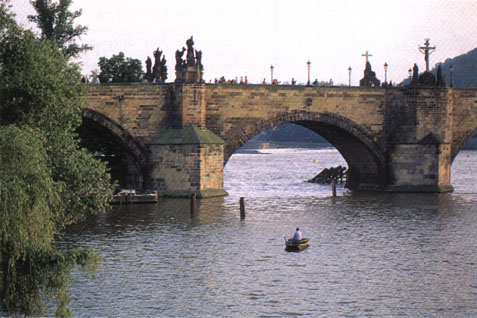
The Charles Bridge, built in 1357, is Prague's most famous landmark and one of the oldest stone bridges in Europe. At one time, four horse-and-carriages would thunder down it abreast; now, only pedestrians, tourists, hawkers, buskers and pink-robed Hari Krishnas stroll or linger between the bridge's 30 stone statues. If you look carefully, you'll see a cross with five stars near the figure of Jan Nepomuk. Confessor to the Queen, Jan refused to repeat to jealous King Vdclav IV what Her Highness had divulged in the confessional. In a rage, the king had Jan tortured and heaved into the icy Vltava. Legend says that as he hit the water, a halo of five golden stars appeared. Touch the stars and make a wish, the saying goes, and you will be guaranteed your wish and a return trip to Prague.
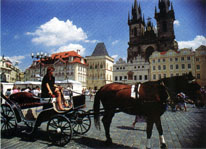 From the bridge, it's only a few blocks to Old Town Square and Prague's second most famous sight. For 500 years, every hour, on the hour, people have collected around the Town Hall to stare at an Astronomical Clock built about 1410. The show begins when twin doors open and 12 apostles march out of the mechanism. A grim figure of Death then turns an hourglass upside down and rings the death knell, Vanity looks into a mirror, Greed shakes a money bag and, finally, a cock crows. According to legend, the eyes of the clockmaker were put out after his work was done, so that he could never duplicate this masterpiece.
From the bridge, it's only a few blocks to Old Town Square and Prague's second most famous sight. For 500 years, every hour, on the hour, people have collected around the Town Hall to stare at an Astronomical Clock built about 1410. The show begins when twin doors open and 12 apostles march out of the mechanism. A grim figure of Death then turns an hourglass upside down and rings the death knell, Vanity looks into a mirror, Greed shakes a money bag and, finally, a cock crows. According to legend, the eyes of the clockmaker were put out after his work was done, so that he could never duplicate this masterpiece.
Old Town Square is dominated by a towering bronze statue of the martyr, Jan Hus, a 14th-century theologian who was burned at the stake for challenging the authority of the Catholic church. Hus rises from a sea of blackened stone figures, who seem to writhe below him. Each summer, on the steps below these figures, is another sea of bodies - some writhing, others eating, sleeping, hugging, playing instruments or talking about how nice it is to be young in the city of Prague.
Josefov, just north of the Square and past a long line of art nouveau mansions, is Prague's historic Jewish neighborhood, where poignant artifacts recall a once-flourishing medieval Jewish world. During the Nazis' relentless rampage, Hitler collected Jewish objects and documents from all over Europe and transported them to Prague. His morbid idea was to create a museum to a race of people he planned to make extinct. Of the 35,000 pre-war Jews in Prague, five-sixths were annihilated. Josefov, however, remains a stunning memorial to all those who perished here and in the rest of Europe. Legend says that stones from the Temple of Solomon were miraculously incorporated into the foundations of Josefov's 13th-century Old-New Synagogue, and, on judgment Day, these would be returned to Jerusalem. The 15th-century Jewish Cemetery nearby is probably one of Europe's most photographed cemeteries; its headstones lean helter-skelter, this way and that, one atop another. The most famous is that of Rabbi Low, who created the fabled Golem, a Frankenstein-like creature fashioned of clay.
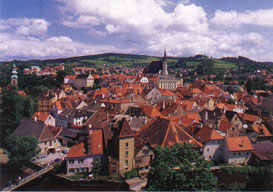
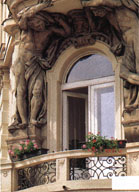
To see Prague Castle and all its cathedrals, chapels, gardens, basilicas, museums and palaces would take a week or more, but if you can only see one thing, don't miss the soaring Gothic St. Vitus Cathedral, which evolved over a span of 600 years. Jan Nepomuk's tomb is here, almost two tonnes of glistening silver crowned by an angel holding a silver tongue. According to legend, this was the only part of Jan recognizable after his body was recovered from the Vltava. The queen he so loyally defended placed his tongue in the confessional to commemorate his silence; the tongue was later encased in silver. The castle district also includes the Knights' Staircase, up which ancient knights rode to compete in jousting tournaments; the Bohemian art gallery, the Singing Fountain and the library at the Strahov Monastery. For photographers, Golden Lane is also a must - if you can find a time when the narrow street isn't cluttered with tourists. The king's alchemists lived here, trying to turn lead into gold, as did the great Czech novelist, Franz Kafka (in house number 22, now a museum.) Of all the city's favorite sons, perhaps the ones who loved it most were its musicians. Anton Dvorák spent most of his life in Prague, as did Bedrich Smetana. Mozart visited many times and lived in the city while composing some of his greatest works. Beethoven, von Weber and Liszt came here, too. For them, like us, the stunning architectural beauty of Prague is like a symphony in stone. Goethe called music "frozen architecture,15 and Prague, of all European cities, proves him right.
Of all the superstitions an tales in the City of Gold, I can testify that one is absolutely true. On my first visit in 1990, my wish on Jan Nepomuk's crown of stars was to return to Prague. I haven't missed a year since.
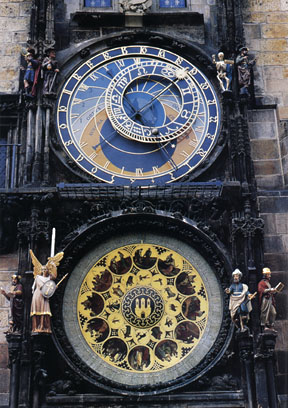
For more information, contact the Czecb Republic Tourist
Information Office at 22 College Street, Suite 200, Toronto, Ontario
M5G 1 Y6. Tel: (416) 929-3700; Fax: (416) 962-3492; Internet: www.czechtourism.com.
BEYOND PRAGUE
As Paris is not France, neither is Prague all there is to see in the Czech Republic. Scattered within an easy day-trip's distance are small towns filled with architectural treasures and more stories.
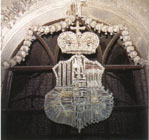 Kutná Hora (an hour by train from Prague) was the most important town in Bohemia during the Middle Ages, with a population equal to London's. Silver poured from its mines, and wealthy craftsmen created such treasures as the Gothic St. Barbara's Church, called one of the loveliest in Europe. It bristles with pinnacles and flying buttresses, setting the mood for other Gothic treasures, such as the Kasna fountain near the main square. The town also has an ossuary, where the bones of monks (in a strange form of piety) have been shaped into decorative garlands and chandeliers.
Kutná Hora (an hour by train from Prague) was the most important town in Bohemia during the Middle Ages, with a population equal to London's. Silver poured from its mines, and wealthy craftsmen created such treasures as the Gothic St. Barbara's Church, called one of the loveliest in Europe. It bristles with pinnacles and flying buttresses, setting the mood for other Gothic treasures, such as the Kasna fountain near the main square. The town also has an ossuary, where the bones of monks (in a strange form of piety) have been shaped into decorative garlands and chandeliers.
Cesky Krumlov is the second most-visited town in the Czech Republic, and, once there, you'll understand why. People fall instantly in love with the medieval feel of the town, the immense castle, which looms over the town like a crouched cat, and the gaslight that spills onto the cobblestone streets at night.
Romberk, a little further up the Vltava River, is a pretty village with a 13th-century fortress towering above and a 12th-century circular tower nearby. About 15 minutes further, Vyssi Brod is home to a dazzling white, once extremely wealthy, Cistercian monastery founded in the 13th century.
IF YOU GO
Getting there: CSA, Czech Airlines, offers non-stop flights to Prague twice a week from Toronto's Pearson International and Montreal's Dorval airports.
Visas: No visas are required for a stay of up to 180 days.
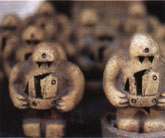 Where to stay: I discovered what may be the best bargain in expensive Prague this summer - the newly opened Cloister Inn (Bartolomejska 9; tel: 02/232 77 00; fax: 02/232 77 09), which is not only affordable and a few blocks from theatres, Charles Bridge and Old Town Square but also has a fascinating history.The building was originally a medieval convent and was later occupied by the Grey Sisters of St. Francis. The only piano concert ever performed in Prague by Beethoven was nearby, and, during the communist regime, the secret police detained prisoners in the convent cells. The Inn's most famous prisoner was Václav
Where to stay: I discovered what may be the best bargain in expensive Prague this summer - the newly opened Cloister Inn (Bartolomejska 9; tel: 02/232 77 00; fax: 02/232 77 09), which is not only affordable and a few blocks from theatres, Charles Bridge and Old Town Square but also has a fascinating history.The building was originally a medieval convent and was later occupied by the Grey Sisters of St. Francis. The only piano concert ever performed in Prague by Beethoven was nearby, and, during the communist regime, the secret police detained prisoners in the convent cells. The Inn's most famous prisoner was Václav
Havel, now president of the Czech Republic, who recently returned to the hotel to show Prince Charles where he was incarcerated. Rooms are immaculately clean, the breakfast (included) is delicious and the Inn may have the friendliest staff in Prague.
 bouncing off the domes of churches, flooding the streets and suffusing the whole city. It's easy to see why Prague has always been called the City of Gold. It's been that way since the days of Charles IV, the "builder king," the man responsible for just about everything ancient in the city. Charles not only made Prague the capital of the Holy Roman Empire and founded the first university in Eastern Europe in 1348, he also gilded the lead roofs of the towers and defensive walls.
bouncing off the domes of churches, flooding the streets and suffusing the whole city. It's easy to see why Prague has always been called the City of Gold. It's been that way since the days of Charles IV, the "builder king," the man responsible for just about everything ancient in the city. Charles not only made Prague the capital of the Holy Roman Empire and founded the first university in Eastern Europe in 1348, he also gilded the lead roofs of the towers and defensive walls.
 From the bridge, it's only a few blocks to Old Town Square and Prague's second most famous sight. For 500 years, every hour, on the hour, people have collected around the Town Hall to stare at an Astronomical Clock built about 1410. The show begins when twin doors open and 12 apostles march out of the mechanism. A grim figure of Death then turns an hourglass upside down and rings the death knell, Vanity looks into a mirror, Greed shakes a money bag and, finally, a cock crows. According to legend, the eyes of the clockmaker were put out after his work was done, so that he could never duplicate this masterpiece.
From the bridge, it's only a few blocks to Old Town Square and Prague's second most famous sight. For 500 years, every hour, on the hour, people have collected around the Town Hall to stare at an Astronomical Clock built about 1410. The show begins when twin doors open and 12 apostles march out of the mechanism. A grim figure of Death then turns an hourglass upside down and rings the death knell, Vanity looks into a mirror, Greed shakes a money bag and, finally, a cock crows. According to legend, the eyes of the clockmaker were put out after his work was done, so that he could never duplicate this masterpiece.


 Kutná Hora (an hour by train from Prague) was the most important town in Bohemia during the Middle Ages, with a population equal to London's. Silver poured from its mines, and wealthy craftsmen created such treasures as the Gothic St. Barbara's Church, called one of the loveliest in Europe. It bristles with pinnacles and flying buttresses, setting the mood for other Gothic treasures, such as the Kasna fountain near the main square. The town also has an ossuary, where the bones of monks (in a strange form of piety) have been shaped into decorative garlands and chandeliers.
Kutná Hora (an hour by train from Prague) was the most important town in Bohemia during the Middle Ages, with a population equal to London's. Silver poured from its mines, and wealthy craftsmen created such treasures as the Gothic St. Barbara's Church, called one of the loveliest in Europe. It bristles with pinnacles and flying buttresses, setting the mood for other Gothic treasures, such as the Kasna fountain near the main square. The town also has an ossuary, where the bones of monks (in a strange form of piety) have been shaped into decorative garlands and chandeliers. Where to stay: I discovered what may be the best bargain in expensive Prague this summer - the newly opened Cloister Inn (Bartolomejska 9; tel: 02/232 77 00; fax: 02/232 77 09), which is not only affordable and a few blocks from theatres, Charles Bridge and Old Town Square but also has a fascinating history.The building was originally a medieval convent and was later occupied by the Grey Sisters of St. Francis. The only piano concert ever performed in Prague by Beethoven was nearby, and, during the communist regime, the secret police detained prisoners in the convent cells. The Inn's most famous prisoner was Václav
Where to stay: I discovered what may be the best bargain in expensive Prague this summer - the newly opened Cloister Inn (Bartolomejska 9; tel: 02/232 77 00; fax: 02/232 77 09), which is not only affordable and a few blocks from theatres, Charles Bridge and Old Town Square but also has a fascinating history.The building was originally a medieval convent and was later occupied by the Grey Sisters of St. Francis. The only piano concert ever performed in Prague by Beethoven was nearby, and, during the communist regime, the secret police detained prisoners in the convent cells. The Inn's most famous prisoner was Václav